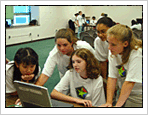 |
Girls As Designers

PIs: Carrie Heeter, Rhonda Egidio, Punya Mishra
Team: Randy Russell, Norm Lownds
This project has been funded by the National Science
Foundation and will begin in January, 2003. The proposal summary
appears below. To view the complete proposal, click
here.
OBJECTIVES
Virtual environments are increasingly being called upon to advance
science learning. With possibilities for interactive multimedia
displays and learner customization, these environments hold great
promise. But are these environments friendly to girls? Computer
games, designed by young men for boys and young men, epitomize technology’s
exclusion of girls, their interests, and values. Less obvious but
more devastating, this technological estrangement exacerbates girls’
lack of interest and self confidence not just in computers but in
science. Technology itself and even the design of technology-enhanced
science experiences may disadvantage girls, turning them away from
SMET instead of engaging them. Experts urge more women and girls
to become involved in software and hardware design, to begin to
transform computer culture. The “Involving Girls as Designers”
(IGD) project will look at what can happen when girls design their
own technology-enhanced science learning experiences. Do girls and
boys approach the design process differently? If so, what are the
characteristics of a girl-friendly design process? Do all-girl design
teams create products that are more appealing to other girls than
products designed by all boy teams? Are gender differences more
strongly polarized by the end of middle school, or are they equally
evident even in fifth grade?
METHODS
IGD will invite small teams of girls to experience and critically
assess a series of high quality science-learning experiences diverse
in their technology and extent and form of interactivity, ranging
from planetarium show to role play simulated mission to Mars, from
CD-ROM games to exploring space science on the web, television to
immersive virtual reality. These young, newly expert technologists
will then design their ideal science learning experience, with the
goal of teaching science and inspiring kids to be interested in
SMET. IGD will profile girl reactions to the diverse forms of science
learning. The design process and design outcomes of the all-girl
design teams will be analyzed and compared to all-boy teams. IGD
will compare fifth grade girls (whose enthusiasm for science parallels
boys) with eighth grade girls (whose enthusiasm and self confidence
in science has declined), looking for similarities and differences
in technology attitudes, design process, and design outcomes. Professional
software developers will create visualizations of each team’s
prototype. With no indication of the gender of the designers, each
set of visualizations will be shown to same-age students to discover
whether boys and girls prefer prototypes developed by their own
gender.
INTELLECTUAL MERIT
IGD will test the assertion that involving girls as designers can
impact design process and product and describe gender and age differences.
IGD will contribute concrete understanding of girls’ attitudes
toward diverse forms of technology-enhanced science learning.
BROADER IMPACTS
IGD could provide compelling evidence to software developers about
the critical importance of involving girls as designers and ways
of enabling girl-friendly design processes. IGC could provide guidance
to teachers and curriculum designers about choosing among technology-enhanced
science learning experiences. The PIs teach graduate design research
classes (in education and digital media design). They will involve
their students in the research and integrate findings into their
courses. New understanding about girl-friendly science education
designs will be incorporated into the Mars Pioneer Learning Adventures
initiative and into the overall Comm Tech Lab software design process
and College of Education and Digital Media Arts curricula. |
 |

